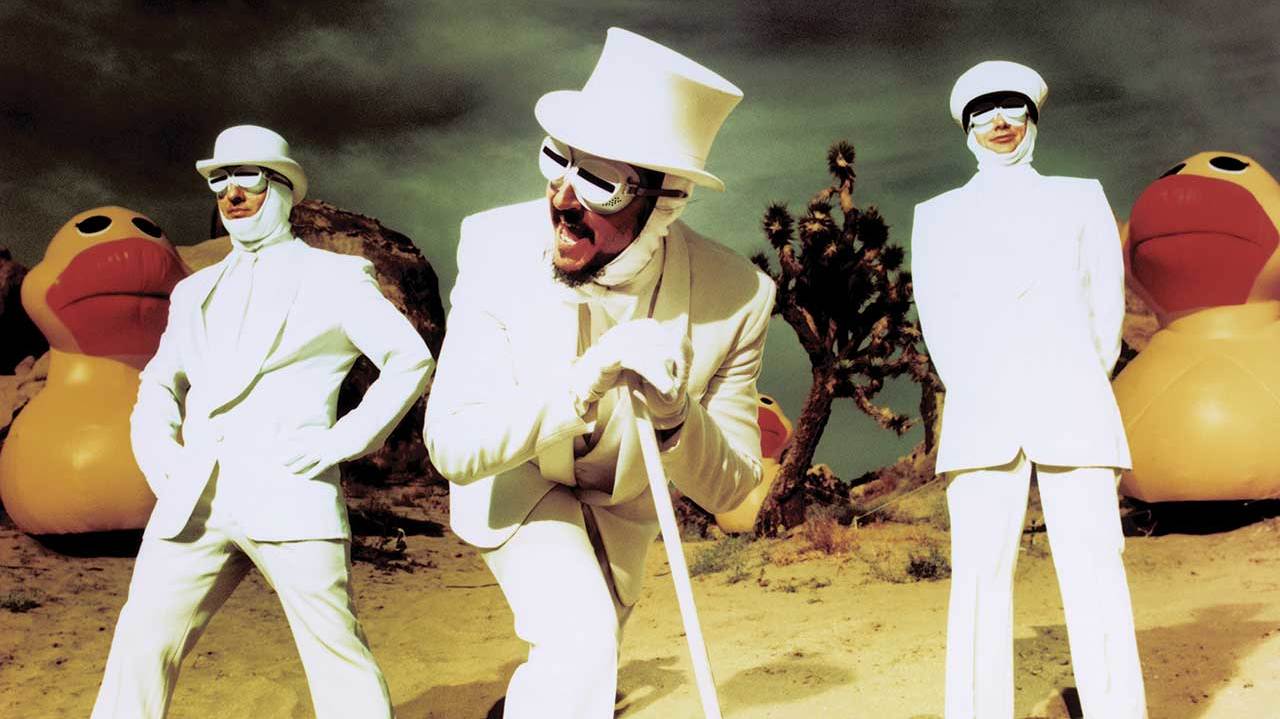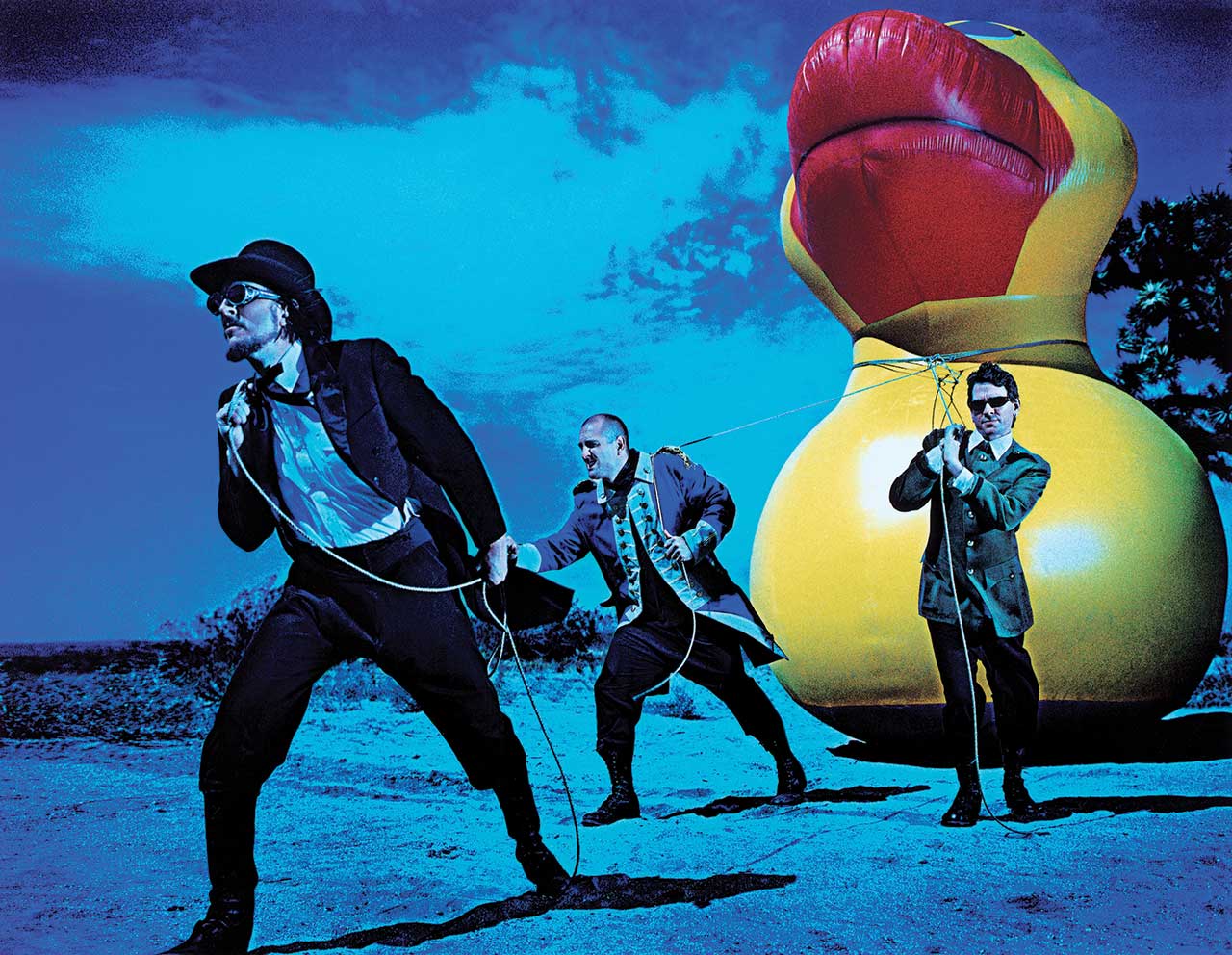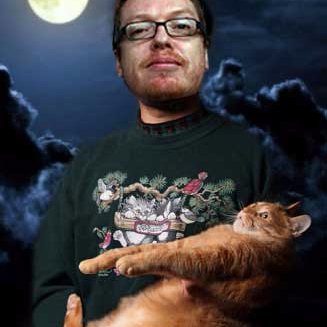Les Claypool takes us through Primus’ multicoloured world
Taking inspiration from the rainbow-hungry goblin protagonists of a 1970s children’s book, Primus are back with another madcap concept album set to spook and spellbind in equal measure

In 1978, the Italian illustrator Ulderico Conte Gropplero di Troppenburg published a children’s book. The Rainbow Goblins was a vivid affair that told the story of seven evil goblins, each named after the colours of the spectrum: Red, Orange, Yellow, Green, Blue, Indigo and Violet. In the tale, the goblins traverse the land stealing the colour from rainbows with their lassos, filling their bellies with its kaleidoscopic goodness. It all comes to a surprisingly violent end for the miniature protagonists, but the story doesn’t end there.
While Ul de Rico – as he’s more commonly known – went on to publish a sequel (The White Goblin, in 1996) and work as a designer on Hollywood blockbusters The NeverEnding Story and Flash Gordon, the goblins have made something of a comeback: their story is retold in new Primus album The Desaturating Seven.
“I’m getting older,” says Primus mainman Les Claypool, speaking to Prog from his home in Sonoma County, California, punctuating his conversation with suitably maniacal cackles. “I’m figuring I need to pull some of the pots off the stove that have been on the back-burner, and this is something that I’ve been thinking about for a long time. My wife used to read The Rainbow Goblins to my kids a lot when they were little. I remember going through it and thinking how amazing it was: the artwork, the colours, the beauty… and yet the darkness, and the creepiness, and the message. It was just an amazing piece of art.
“It was inspiring to me and I wanted to supplement it with my obscure interpretation and perspective. Obviously it’s also fairly relevant to what’s going on today. It just seemed like the right time.”
Thinly veiled political sentiments aside, the album manages to capture the book’s prismatic yet black-hearted vibrance perfectly. From the ominous spoken-word introduction – read by Tool bass player Justin Chancellor (“the champion goblin,” says Claypool) – to the story’s startling denouement, it’s an album that conjures up images of peculiar lands, epic journeys and dark, sinister activity with some considerable degree of skill. From the stumbling lurch of The Valley, with its spookily disembodied vocals that sound as if they were recorded underwater, via the stuttering The Seven – a song with a cadence that makes it feel like a demented, foreboding sequel to John Walter Bratton’s Teddy Bear’s Picnic – to the off-kilter, racing drama of the climactic The Storm, it’s an album full of squirting rhythms, lolloping basslines and enormous mischief. It’s like a nursery rhyme set to some form of alien, disjointed jazz, but it somehow succeeds in breathing life into Ul de Rico’s deviant story.

“That’s what I’ve always tried to do with Primus stuff,” says Claypool. “We’ve never been about taking it to the dance floor-type lyrics. It’s always been about visuals and trying to evoke some interesting pictures through music. The visual element has always been a very strong part of what we do live, given the parameters of what we can afford. We’re not Radiohead, who have a little bigger production budget than we do, but we come up with some pretty cool stuff. For me, the images Ul de Rico painted for this thing are so spectacular and so strong I just really wanted to support that as best I could and not detract. At times it was incredibly easy, and at times it was difficult.
“The biggest challenge was to write lyrics about goblins and rainbows and it not to come off like a Tenacious D song. It could easily be interpreted as some form of parody, and if you look through the lyrics I don’t often mention goblins and very rarely mention rainbows. Instead I use the notion of the metaphors that are implied in the story.”
Sign up below to get the latest from Prog, plus exclusive special offers, direct to your inbox!
Given the epic nature of the tale, it’s something of a triumph that in an age where attention spans are lower than ever and yet 70-minute albums are the norm, Primus managed to bring the album to a frothing climax in just over half an hour. “That, to me, is the folly of CDs,” says Claypool. “I don’t want to hear 20 songs by my favourite artist. I’d rather hear 10 songs and get to suck them in. For me, one of my all-time favourite records as a kid – it was also my first concert – was Hemispheres by Rush, and this record is either a minute or 40 seconds shorter than that. Of course, part of the reason that albums were shorter back in the day was that the more information you put on a disc, the more you included, the more the quality dropped. The grooves got closer together, and you lost the bottom end. So I wanted to make sure it sounded great on a single album.”
Rush aren’t the only band referenced by Claypool as he talks about the album. Lead single The Seven, with its corrugated rhythms and wobbling bass, definitely has an air of Discipline-era King Crimson about it. “There are different eras of Crimson,” says Claypool, “but when I discovered them it was 80s Crimson, the Adrian Belew/Tony Levin Crimson era. That, to me, was Crimson. So when I heard the earlier stuff, I was like, ‘Woah! This is quite a different chapter!’ But those 80s Crimson songs are just spectacular.
“They were very powerful for a young man to hear: Tony Levin and Bill Bruford playing those rhythms together, just the whole package. They’re one of the greatest bands ever. They’re all monsters and they have this chemistry together. When you get a group of individuals – no matter how strong they are separately – and they don’t have that chemistry when they come together, it can be quite interesting. But if they do have that chemistry, it just takes it beyond.”
In August, Claypool and Sean Lennon released the four-track EP Lime And Limpid Green, the follow-up to The Claypool Lennon Delirium’s whimsical debut album of last year, Monolith Of Phobos. Alongside covers of songs by Flower Travellin’ Band’s Satori, Pink Floyd’s Astronomy Domine and The Who’s Boris The Spider was a faithful version of Crimson’s The Court Of The Crimson King. “It’s a phenomenal song to play, record and perform,” says Claypool. “Any time you do a project with other people, you grow, hopefully. Working with Sean, he and I pushed each other in directions that we probably wouldn’t go on our own. He has this incredible ability to form vocal melodies and harmonies, and that was very helpful for me on The Desaturated Seven.”
Another different approach Claypool brought to the recording of the album was by creating a storyboard to lay out the goblins’ tale for the other members of the band, guitarist Larry “Ler” LaLonde and drummer Tim “Herb” Alexander, who interpreted the story in their own way before coming up with their parts. Apart from that, it was business as usual.
“We do everything in my house,” says Claypool, “where I’ve assembled all this old vintage gear. Every now and then I need to kick things to keep them going, but I’m the only one who knows exactly where to kick them, so I’m the only guy who can run it.”
Have his kids heard the album? “They’re adults now,” says Claypool. “And like everything else I do, my daughter thinks it’s incredibly weird, whereas with my son, it’s right up his alley. When I played The Residents in the car when they were little, my daughter would cry and say it was scary, while he loved it and wanted to hear it again.”
The band have been in touch with Ul de Rico, (“a thoroughly eccentric fellow,” says Claypool) to licence the artwork.
“My manager was emailing with him there for a while because we needed his permission to use the artwork and whatnot. To me, a huge part of the pie is utilising all those images. He painted all that stuff on these wood panels, and we’ve had a couple of people do some reproductions of some of it, and it just doesn’t look nearly as good as what he came up with.”
The fruits of the collaboration will be seen when Primus take the goblins on the road, and if all goes according to plan, it’s going to be spectacular. After all, the band set the bar high with the tour for the Primus & The Chocolate Factory album, which reimagined the soundtrack to the classic children’s film Willy Wonka & The Chocolate Factory.
“We have a pretty amazing team that have been part of our visual world for a while,” says Claypool, “and when we did the Wonka thing, we put together a pretty interesting stage show. It started off with us going out and doing the stripped-down production version of Primus, before we opened the curtains of this magical world that was Willy Wonka and the Chocolate Factory, with Oompa Loompas jumping around and lots of video visuals. We’re going to do something similar to that on this. Obviously there’s going to be a lot of rainbows, and lots of goblins. Not a lot of helicopters on this one.”
Prog ends our conversation with Claypool by asking if he’s familiar with synaesthesia, the neurological condition in which real world stimulation is experienced by more senses than would normally be the case. Those affected might see a picture of the sea and immediately taste apricots, or unfailingly think of January as being yellow. One variant, chromaesthesia, results in different musical notes provoking the listener into visualising involuntary, simultaneous bursts of colour. It sounds like the kind of thing Claypool might have a theory or two about, given the visual impact of Primus’s new album and the brilliance of Ul de Rico’s images, but he’s not biting. “I see music in the form of sandwiches,” he chortles, before asking how to spell synaesthesia and writing it down. Don’t be surprised if it shows up on the next album.
Or maybe it won’t. Primus are nothing if not unpredictable.
“I’ve no idea what kind of music I play,” says Claypool. “Maybe I’ll start telling people I play Beatles music… but sideways.”
The Desaturating Seven is out now on ATO Records. See www.primusville.com for details.

Online Editor at Louder/Classic Rock magazine since 2014. 39 years in music industry, online for 26. Also bylines for: Metal Hammer, Prog Magazine, The Word Magazine, The Guardian, The New Statesman, Saga, Music365. Former Head of Music at Xfm Radio, A&R at Fiction Records, early blogger, ex-roadie, published author. Once appeared in a Cure video dressed as a cowboy, and thinks any situation can be improved by the introduction of cats. Favourite Serbian trumpeter: Dejan Petrović.
